May Sky is the official translation of a freeware doujin (similar idea to indie) visual novel from Japan called Gogatsu no Sora. Gogatsu no Sora was originally released in Japan on August 31, 2005. With the consent of the developer, Scrubbing, Gogatsu no Sora was officially translated into English by Insani, a visual novel translation circle, and released in English on December 1, 2008, as May Sky. May Sky was submitted to the 2008 al|together visual novel translation festival along with several other projects. In this post, I will review May Sky as part of my project to review almost all of the visual novels that were translated for the 2005, 2006, and 2008 al|together festivals.
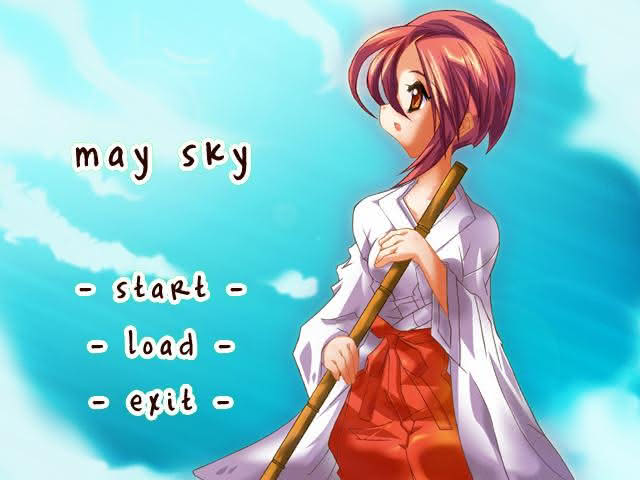
You can learn more about my al|together project by reading my project introduction article. That article includes a running list of our completed al|together reviews. I have a dedicated collection post with links to all of our al|together articles, including reviews, essays, and short posts.
This article is part of my collection of posts about May Sky, Insani's 2008 localization of a freeware Japanese visual novel called Gogatsu no Sora.
May Sky is the longest of the visual novels submitted to the al|togeteher festivals, taking about 4-6 hours to read depending on the reader’s reading speed. It covers the strange May relationship between a 22-year-old salary-man suffering freshman blues at his new company and a 16-year old high school student working at a shrine.
(Non-)Spoiler Notice
This article will constitute a review of May Sky for people who may be interested in reading the visual novel for themselves. For that reason, I will not include spoilers that would ruin the story for someone who would be interested in downloading and playing the visual novel after reading my review. With that being said, I will discuss the story and theme in broad terms, so those interested in enjoying May Sky without that context may bookmark my review for reading after the fact.
I will publish an analysis of May Sky’s story and themes in the future. That analysis will include a discussion of events in the story. I will replace this paragraph with a link to that assessment once I publish it (most likely in August 2022).
May Sky Details

2008 English Version:
| Title | May Sky |
| Translators | Irene Ying (supervised by Seung Park) |
| Release Date | December 1, 2008 |
| Engine | ONScripter-EN |
| Official Website | altogether; Archive |
English Translation
| Title | Gogatsu no Sora. |
| Developer | Scrubbing |
| Release Date | August 31, 2005 |
| Creator Information | About Scrubbing |
| Official Website | May Sky; Developer |
Extra Links
Insani’s al|together 2008 page for May Sky notes that the original Japanese game was released as a web game created with Adobe Flash in addition to an installable game written in NScripter. The Insani translation is unsurprisingly based on the NScripter version of May Sky. The original Japanese May Sky website is still fully intact online with download links and interesting pages including what appears to be a collection of notebook photos.
Downloading May Sky
May Sky remains available as a torrent and direct download from the Insani website for Windows and MacOS.
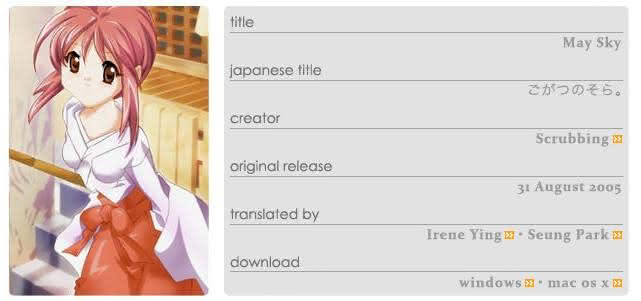
My review was based on running the original Windows May Sky on Linux with WINE. I ran had no issues and did not have to fiddle with my WINE configuration whatsoever. After my review, I tested running May Sky natively on Linux with the Linux ONScripter-EN executable and it also worked with no issues (see how to do this).
General Overview of May Sky
Mr. Seung Park introduced May Sky on the al|together 2008 festival page for the story:
[H]ere we have Haruki Mizoguchi, a newly-minted salaryman who is suffering from the freshman blues, and really doesn’t care about anyone around him. And over there we have Minori Kamiake, a world-weary young shrine maiden who, despite her giggly conversations with her school “friends”, really couldn’t care less about any of that. When taken separately, these two individuals are malcontents, square pegs struggling to fit into round holes, adrift and alone in a society where solidarity is all that matters. When taken together, though … well, suffice it to say that they can be pretty mean to each other.
Seung Park
Haruki is the view-point character for nearly the entirety of May Sky’s six-chapter story. He is a 22-year old salary man in training before he formally takes a starting role with his new company. As Insani’s description noted, Haruki was suffering from “freshmen blues” – living briefly in a place that was unfamiliar to him and staring down a bleak future wherein his life would be consumed by a job that he did not care about at all.

Minori is described in the piece as a high school sophomore. Because high school in Japan spans grades 10-12 in U.S. parlance, I took this to mean that she was the equivalent of an 11th grade student in the United States, and thus either 16 or 17 years old (we can infer she is 16 at the start of the story based on an eventual in-game reference to her birthday). She works part-time as a shrine maiden at a shrine where her Aunt is the head priestess. However, Minori spends more time playing a grand piano at the shrine than she does attending to shrine duties – which seem to consist mostly of light sweeping and occasionally conversing with locals. It was the sound of the piano that initially attracts Haruki to the shrine on one of his aimless walks.
Over the course of the story, Haruki and Minori begin to spend time together. They become, as they both put it, more than strangers but less than friends. It is on account of this strange dynamic that Haruki and Minori speak to each other without pretense or reservation – something that would be unfathomable to them in their daily lives outside the shrine grounds. It is also on account of this dynamic that, as Insani put it, Haruki and Minori “can be pretty mean to each other.” Haruki bemoans his dreary life and depressed state while Minori has no shortage of sharp retorts and complaints about her own life.
While I will not go so far as to spoil the story of May Sky or the ultimate disposition of the relationship between Haruki and Minori, a cursory look at both the Visual Novel Database entry for Gogatsu no Sora and the al|together project page for May Sky reveals that the visual novel is, at least in part, a love story – albeit one that as the translation project manager put it – is not particularly romantic. I will address that aspect of the visual novel in brief in my story assessment section later in this review in light of the materially significant age difference between Haruki and Minori.
The entire main story takes place in a certain May, which gives the visual novel one-half of its name. Through it all, the strange relationship between Haruki and Minori develops, and Haruki is forced to decide what exactly it is that he will do in the present.
Game-Play of May Sky
May Sky features two choices in its 4-6 hour run. Neither of the choices affects the story in a meaningful way. Each of the choices leads to different dialogue for a single scene, but the effects are mostly comedic. May Sky is an entirely kinetic visual novel – meaning no player input other than advancing the dialogue – save for those two choices. Thus, for all practical intents and purposes, May Sky is effectively a kinetic visual novel, or a storybook so-to-speak, rather than a visual novel that invites player interaction.
Visual Presentation of May Sky
May Sky uses modified photographs for its backgrounds – much like several other visual novels that were submitted to the al|together festivals (see e.g., From the Bottom of the Heart; Night of the Forget-Me-Nots; Shooting Star Hill). Those who have played the far better-known Higurashi and Umineko series will find much that is familiar in how May Sky handles backgrounds.
However, unlike some of the similar visual novels that we have looked at, May Sky adds heavy textures to the photographic backgrounds. Moreover, it adds colors to the backgrounds to indicate different times of day.
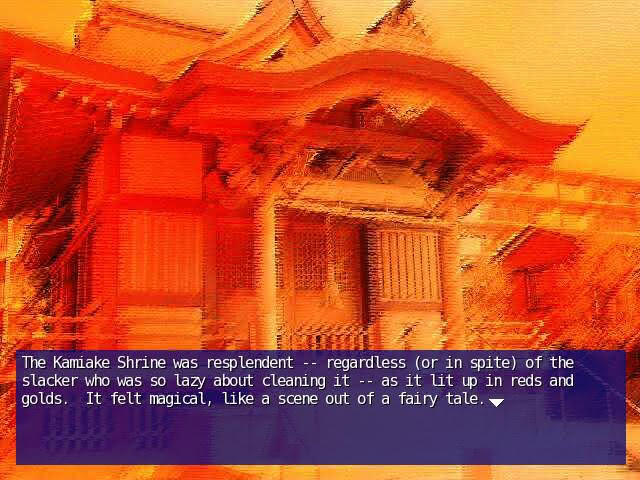
Similarly to Shooting Star Hill, May Sky also features a number of fully drawn scenes featuring Minori (and on occasion, Haruki).
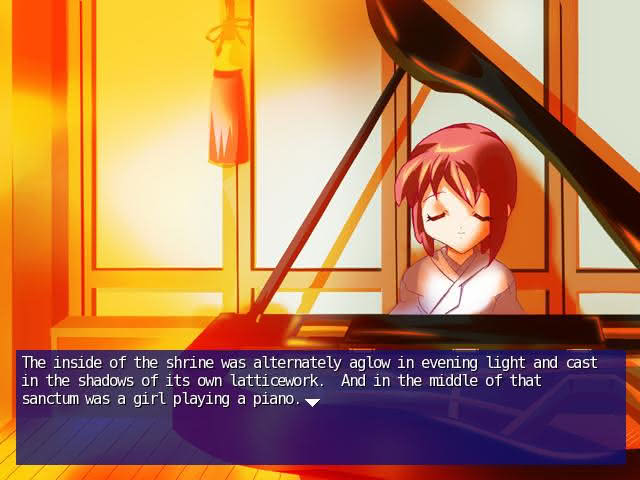
Unlike Shooting Star Hill, May Sky reuses a number of the scenes – sometimes with changes to reflect different times of day or different weather conditions.
May Sky also makes use of blank backgrounds in a number of instances – where there is nothing other than a black or white screen and the text box. This effect is used almost exclusively for Haruki’s monologues – although most of Haruki’s monologues take place against an ordinary photographic background. I used one such example in the introduction to the instant article, wherein I clipped a text box that had been placed against an empty white background.
Minori is the only character who has a character sprite – although Haruki is depicted in some of the fully drawn scenes. Minori has a variety of expressions to match her dialogue. In almost all of the scenes in the game, she appears in her miko (shrine maiden) robes, meaning she does not have a great variety of outfits.

On the whole, the visual presentation of May Sky was adequate for its purposes. While I think it over-did the textures on the photographic backgrounds a bit, the team behind May Sky did a good job of depicting different times of day. The few fully drawn scenes were well-done, although not on the level of an al|together project that I praised, Shooting Star Hill. I did not like Minori’s character design at first, but it grew on me a bit throughout my play-through, and the team gave her a wide range of portraits to match her dialogue and hot-and-cold personality. Most of the portraits work with Minori’s style, although a few look unduly awkward.
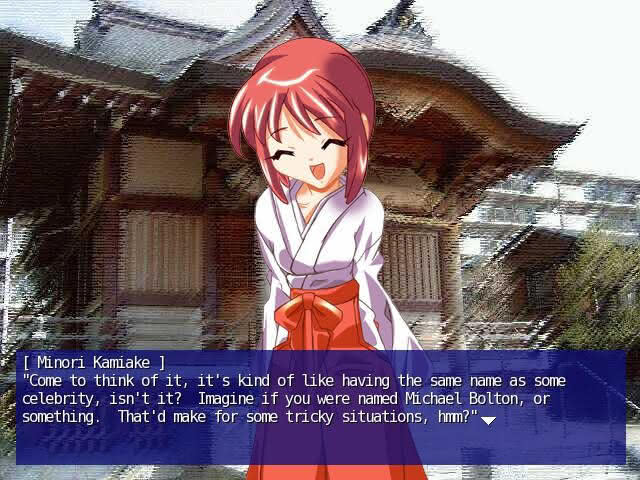
While I would have still opted for a somewhat different style, Minori was memorable in a positive way after I had finished reading the story.
Audio Presentation of May Sky
The events of May Sky begin in earnest when Haruki hears the sound of a piano off in the distance while he walks. Given the centrality of Minori’s piano-playing, one would expect the May Sky team to have given the soundtrack attention. It did not disappoint – boasting a soundtrack list of 23 songs by seven composers.
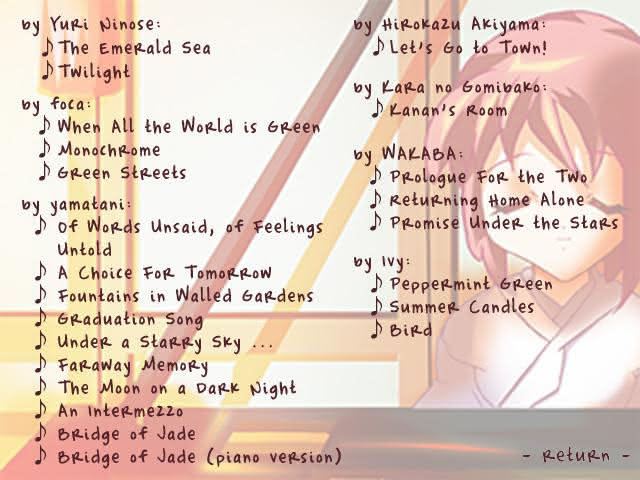
All of May Sky’s songs function largely as background music, but they are well-suited to the task. On many occasions while playing, I let May Sky sit while I captured a screenshot for reference for this article and my forthcoming analysis piece. As a result, I often allowed the background songs to play for longer than I would have if I were reading May Sky straight through without taking screenshots. The tracks are longer than I would have expected, meaning that most readers should seldom notice a song looping within a single scene.
In what should come as no surprise given the focus on Minori’s playing the piano, all of the background songs evince a piano sound. Moreover, the game uses certain tracks when Minori is shown playing the piano, blending the soundtrack into the story proper. The sound tracks are delicate, varying in tone from cautiously upbeat to melancholic to contemplative.
May Sky’s soundtrack was diverse enough to never become repetitive and was a good match for the story’s themes and aesthetics. The only mild qualm that I have is that the transitions between songs when the scene changed often felt abrupt – which serves as a contrast to an American freeware visual novel with catchy background music that I reviewed, Save the Date.
Notes on Technical Aspects
May Sky gives the player nine save slots. In light of the fact that the story is neatly broken up into six chapters and does not have branching paths, these save slots should be more than enough for all normal purposes. May Sky allows players to save before making one of the visual novel’s two choices – meaning that it is not at all difficult to see the small effects of those choices on a specific scene without having to play through May Sky twice.
May Sky does not have a “skip” button like many other visual novels. However, the player can rapidly skip through dialogue by pressing Control.
It is possible to scroll back through a certain number of lines in the text by activating the log menu from the options or using the scroll wheel. One feature that I appreciated was the ability to access the text history after restoring from a saved file – which is not the case in all visual novels. However, I found that pressing enter or left-clicking to advance the text did not work when reading through the text history. Instead, the reader must scroll back to the present in order to continue reading.
Translation Quality
The official website for May Sky provides copious translation notes from the lead translator for the project, Ms. Irene Ying, and her supervisor, Mr. Seung Park.
I have been consistently impressed with how well all of the al|together translations read in English, and May Sky is no exception. I noticed very few instances of awkward phrasing, and both Haruki and Minori had clear and consistent voices throughout the story.
May Sky’s dialogue was more complex than any of the previous al|together visual novels that I reviewed thus far, with there often being subtext beneath Haruki’s and Minori’s dialogue and Haruki’s monologues. The meaning behind their thoughts and sentiments was intelligible because of the clear translation.
Both Ms. Ying and Mr. Park indicated that May Sky was a difficult game to translate on account of a variety of issues. Setting aside some of the technical problems that they experienced (described in their statements), they noted that many of the Japanese phrases and puns in the game – many of which involved “May” – were not easy to translate into English.
Ms. Ying wrote of some of the challenges:
I reread May Sky multiple times, but not enough – I failed many times to realize I was setting up for the next scene. Possibly the hardest lesson for me to learn was listening to the voices of the speakers while I read. In this case I could barely tell what their voices were; I (sometimes) knew what they were saying but couldn’t see the style of their words. I missed their humor, their insights, and their irony. I completely did not realize that Chapter Six was written in the present tense. So you can see how all this was one very long lesson to me in listening to the piece and the characters inside. If I’d had more time that’s what I would have tried to focus on more. Since that was not the case, I will be spending some time after the release to study the original and the translation more.
Irene Ying
Mr. Park noted that the end-result was imperfect:
There were many other issues with the translation, of course — nobody’s perfect, and Irene’s a relatively inexperienced literary translator. I’m therefore not going to do a comprehensive postmortem of those, as I’d be sitting here writing this peer review for months if that were the case. Irene addresses some of the issues that impressed her most in her translator’s note anyhow; give it a read if you wish. Suffice it to say, then, that this script was in some places a very incorrect translation, in other places a merely incorrect translation, in still other places a competent but clumsy translation, and in certain places a totally brilliant translation.
Seung Park
Both Ms. Ying and Mr. Park noted that Ms. Ying’s translation clicked on all parts of the story that revolved around food. Fortunately, many scenes involved food – so that covered a non-insignificant amount of the text.
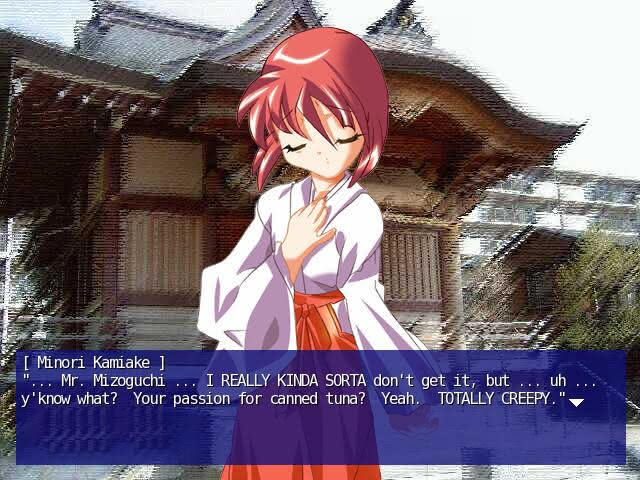
As I have noted on a number of occasions, I cannot assess the fidelity of translations of Japanese games to their original counterparts because I do not read Japanese. For that reason, I judge the English version of games such as May Sky as the end products in and of themselves, largely evaluating the translation for writing quality and how it reads in English. With that being said, there are a few notes that I can make about the translation specifically.
Firstly, the translation liberally uses all caps to indicate yelling, outbursts, or eureka moments. In general, this worked well enough – but I would be more inclined toward plain-old exclamation points (I assume that italics for emphasis were not an option with the game engine that powers May Sky).
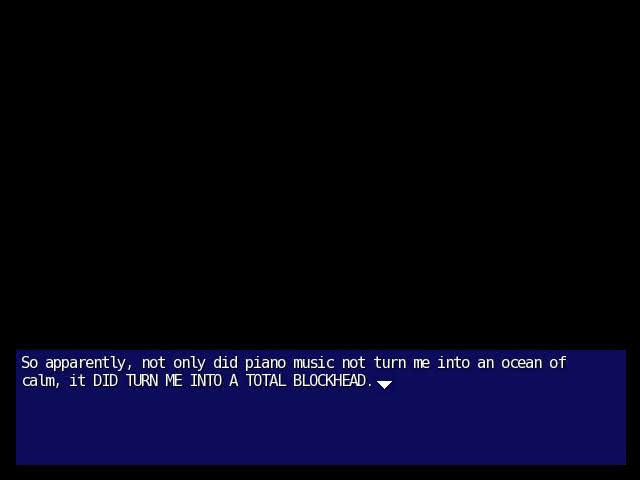
Secondly – the translation notes of Mr. Park and Ms. Ying noted several ways in which they found English analogues for Japanese sayings on significant points in May Sky – mostly related to terms involving May. This technique was also utilized on less important points. For example, Haruki often refers to Minori as the “Iron Maiden” – a reference that conveyed his assessment of Minori reasonably well (although “Ice Queen” may have worked better in some instances from my own reading of the story). There were one of two instances wherein Haruki and Minori referenced what I believe were American celebrities – although I did not recognize them (thus, the attempt to make it intelligible to English readers failed on me there). I tend to not like obviously out-of-place references, but the logic of that swap makes sense in light of the overall translation philosophy described by Mr. Park in his translation review. There was one instance where Haruki quoted chef Emeril Lagasse (“Kick it up a notch! Bam!”) – which runs the risk of not aging particularly well (assuming that was a translation choice to make the text more accessible to English readers rather than an indication of Mr. Lagasse’s immense popularity in Japan in 2005).
Speaking only from the perspective of an English-reader, our definitive English version of May Sky reads better than many commercial efforts and the dialogue conveys the complicated sentiments of Haruki and Minori quite well.
Story Structure
Nearly all of May Sky’s main story takes place in May of an unspecified year (I assume the authors had a year in the late 90s or early 2000s in mind). May Sky’s main story has six chapters. Those six chapters are broken into days – May Sky always highlights the specific day in which a scene is taking place. Many of the days have multiple scenes.
Reading through May Sky’s entire main story unlocks a bonus scenario called August Snow. This scenario, which covers only a couple of days, is about one-quarter of the length of the main story. For purpose of the instant section, I will only note that August Snow otherwise has the same structure as the main story.
Writing and Story Quality
Given its length, May Sky is one of the most ambitious of the al|together visual novels. Fortunately, it is also one of the best-written and best-conceived. It is a compelling read from start to finish, consistently moving the plot forward in subtle ways, adding new dimensions to the mercurial main character duo, and building up to certain definite conclusions.
As Insani noted, May Sky is, at its core, the story of two people who feel alienated from society and from those around them who find someone to confide in. Much of anyone’s enjoyment of the story will depend on their views of the flawed main characters.
Haruki is, with one small exception that is beyond the scope of this review, the view-point character for the entirety of May Sky. Haruki himself is a relatively straightforward character, expressing his current sentiments through monologues and also adding his own contemporaneous internal monologue to his conversations with Minori.
Haruki is sympathetic in some ways and deeply flawed in others. Having just left college with hopes for his future, Haruki quickly found himself disillusioned upon beginning a job that he had little interest in and moving temporarily to a new place for training where he knew no one. It is clear from the start of the story that Haruki largely failed to find friends and had few hobbies or pastimes to look forward to when he was not engaged in his job training. His monologues betray a certain dreamy, aesthetic sensibility, looking for an outlet against what he saw as a very dreary, gray future as a salary-man. One might describe Haruki, at his most contemplative, as a very poor man’s version of a certain factory girl whose essay I covered in mid-May of 2022.
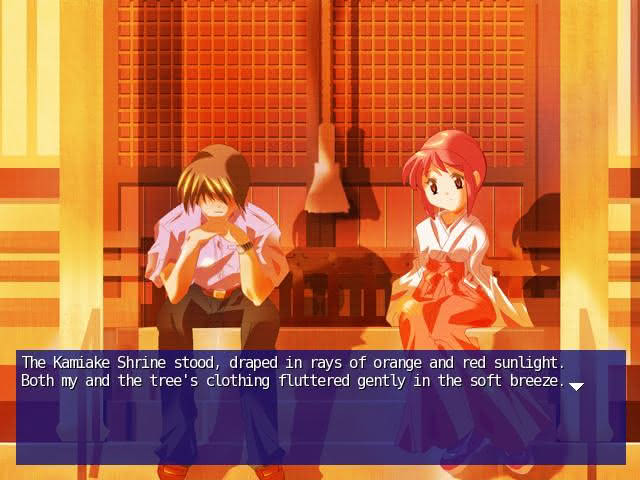
Haruki is flawed in several respects. He is highly self-involved and indecisive. Moreover, one cannot omit the fact that one of his instincts is to dump his existential work-life concerns on a high school girl – which does not suggest that he is an entirely well-adjusted young adult.
The reader’s perception of Minori is necessarily colored by Haruki’s view of Minori. That is, the player follows Haruki when he is not with Minori. There are many scenes wherein Haruki talks to himself while he is in his apartment or on a walk or which provide a brief preview of events that he is about to recap. We only see Minori when Haruki is with Minori. Thus, the only side of Minori that the player gets to know is Minori when she is with Haruki.
Minori has a clear aesthetic sensibility which has a definite and immediate impact on Haruki. Her early beautiful description of May plays into the visual novel’s thematic motif. Minori enjoys Haruki’s company and banter, wherein she can show off her tendency for comic violence and outburts, both of which the reader is led to understand she suppresses in her day-to-day life. Yet Minori, like Haruki, is a flawed character. Minori is fundamentally a high school student with high school problems, and not a particularly mature one notwithstanding her occasionally profound sentiments.
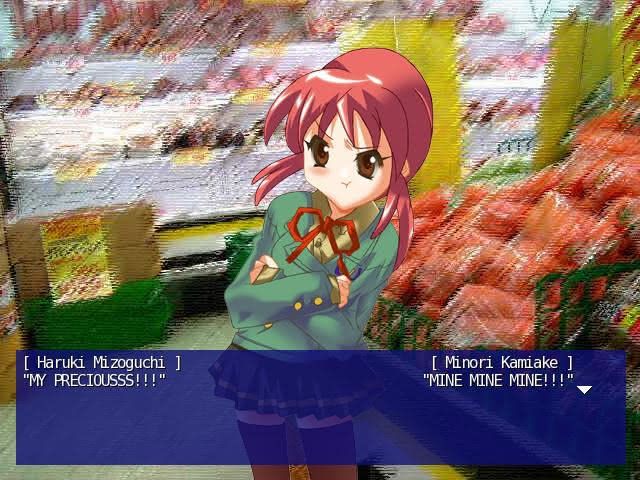
While Haruki suffers from being introspective to the point of excessive self-involvement, Minori is more self-involved by an order of magnitude than Haruki is (albeit – it is perhaps more forgivable given her age).
On the whole, I found both Haruki and Minori to be compelling characters – and the visual novel stuck to logically telling the story from Haruki’s perspective and vantage point. Throughout the month of the main game, we see the subtle ways in which Haruki’s and Minori’s banter changes them – although I will refrain from discussing in which ways they change.
May Sky as a Romance
Before I continue to the bonus content in May Sky, I will briefly address the extent to which May Sky is a romance story. I will endeavor to do so without spoiling the disposition of their relationship (or lack thereof). It is especially worth addressing in light of the materially significant age difference between Haruki (22) and Minori (16/17).
On the al|together 2008 homepage for May Sky, Mr. Seung Park paraphrased a contemporaneous review of the original Japanese Gogatsu no Sora:
[F]or a supposedly romantic piece it doesn’t feel all that romantic.
That sentiment is well-put.
Haruki and Minori initially meet when Haruki is, for reasons he does not fully understand, attracted to Minori’s shrine by the sound of what turned out to be her playing the piano. After Haruki goes to the shrine to listen to Minori on a couple of occasions, they become fast acquaintances. Haruki enjoys killing time at the shrine and Minori is moved that someone enjoys her music.
The relationship between Haruki and Minori is not driven by romantic interest for much of the story. Both Haruki and Minori feel alienated from society in their daily lives but for different reasons. Their strange relationship, which initially exists only within the confines of the shrine grounds – is defined by their being more than strangers and less than friends.
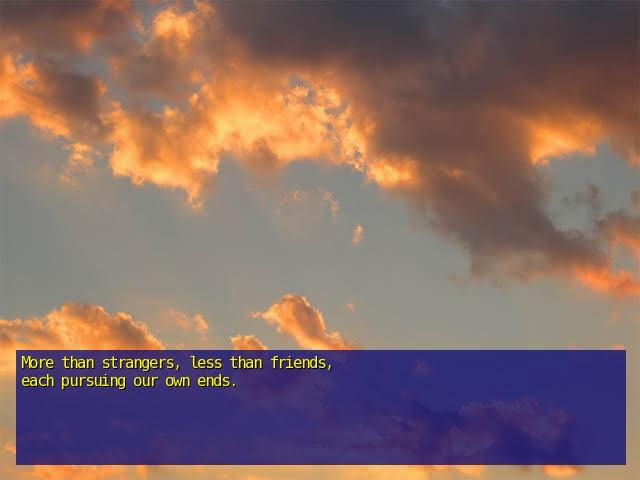
That both Minori and Haruki were not a part of each other’s real lives allowed them to act without their usual reservations, both for better and for worse.
Some of Haruki’s early dialogues allude to vague romantic feelings – although these largely stem from the fact that someone, notably a girl, was actually talking to him. Minori seldom evinces much sentimentality about people, but it is worth noting that we do not have access to her inner-thoughts in the same way that we have access to Haruki’s monologues.
As the story progresses, the idea that there is a romantic dimension to the relationship between Haruki and Minori becomes more plausible, albeit the fate of their feelings is not resolved until the latter stages of the visual novel. To the extent that there is a romantic element to May Sky, it is an entirely chaste affair.
Bonus Content
Reading through all six chapters of the main May Sky story unlocks several bonus options on the menu. These options include an image gallery (all of the fully drawn scenes in May Sky), a music select screen (allows the player to listen to any of the music tracks, sorted by composer and title).
I was not surprised to find an image gallery and jukebox after I finished May Sky. However, having gone in mostly blind, I was surprised to see a new item on the menu: august snow. August Snow is an extra scenario that takes place after the first six chapters of May Sky. As I noted earlier – it is surprisingly long. While I did not endeavor to take an exact measurement, I would guess it is somewhere in the neighborhood of 20-25% as long as the main story. For obvious reasons, I will refrain from saying anything about August Snow in this review other than that the scenario was of comparable quality as May Sky proper.
Completing the game also changes the background image of Minori on the May Sky title screen.
Overall Review and Assessment
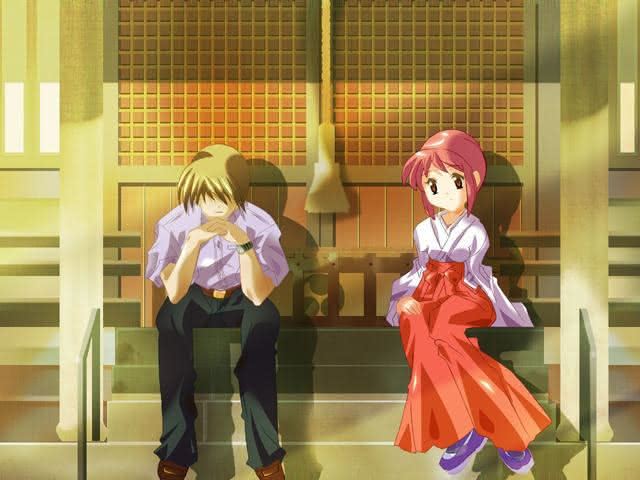
The al|together visual novels vary in terms of quality, scope, and ambition. May Sky is one of the most impressive al|together translations on all three counts. The final English version of May Sky reads well and depicts a month in the life of two interesting characters with many layers to their personalities. While it suffices to describe the visual presentation of May Sky as adequate, its soundtrack was quite good and gave it an overall memorable aesthetic. While May Sky is not a particularly long visual novel in the grand scheme of things, it is relatively long for a freeware doujin project made with limited resources. May Sky maintained its high quality from the first scene through the August Snow scenario – staying interesting throughout and building toward a satisfying conclusion for the main characters.
While I regard May Sky as one of the more technically impressive al|together visual projects, it is not necessarily as easy to recommend universally as From the Bottom of the Heart (high quality and about 10 minutes to read) or Shooting Star Hill (some similar concepts, shorter, and higher visual production values in its smaller package). May Sky is almost entirely the story of conversations between Haruki and Minori, and one’s interest in those characters and their flaws will necessarily control whether he or she enjoys the package as a whole. Moreover, while there are many visual novels that are far longer than May Sky’s 4-6 hours, the lack of player input in this particular vicual novel may be a deterrent for some prospective readers. Finally, even were one to entirely remove the romantic undercurrents from the story (focus entirely on their relationship being between that of strangers and friends)– the age difference, specifically in light of Minori’s being a high school student, does color one’s perception of Haruki’s own actions and maturity.
On the whole, May Sky is a technically impressive visual novel in terms of writing quality, consistency, and musical presentation – and it compares favorably to most newer commercial visual novels in all three respects. It makes for compelling reading and is genuinely sentimental and meaningful in its best moments. I recommend giving it a try if you enjoy visual novels generally, and I especially recommend it if my broad description of its themes and main characters sound interesting to you.
Finally, I will write a separate commentary on May Sky’s story in the future – much like I produced for From the Bottom of the Heart and Shooting Star Hill in previous reviews. If you plan on fully enjoying that piece, I encourage you to read May Sky for yourself first. I will replace this section with a link to the review once it is posted (most likely in August 2022).
Update Notes
On February 29, 2024, I added additional links and information to the details section and I added a note about running May Sky natively on Linux instead of running the Windows version on WINE. For those who are following my al|together project generally, I encourage you to see my final al|together novel ranking (see intro) wherein May Sky occupies a very prominent position. On September 21, 2024, I published a four-part analysis of May Sky.